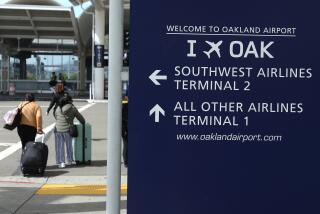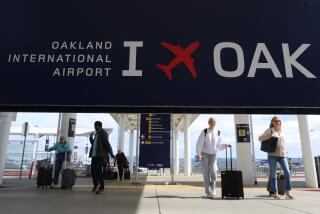California Commute: What’s at stake in remodeling Burbank Airport
Officials generally agree that the Burbank Bob Hope Airport passenger terminal is cramped, outdated and obsolete. Opened 85 years ago, the terminal is so close to the runway that it does not meet federal design safety standards. The terminal also doesn’t meet seismic standards and could be so heavily damaged in a major earthquake that it could go out of service.
Airport officials have long sought a new terminal since aerospace giant Lockheed Corp. sold it in 1978. But the effort has been stalled for various reasons over the years. Most recently, a renewed fight between the Burbank-Glendale-Pasadena Airport Authority and the Burbank City Council has halted progress on designing a new terminal.
Both sides have come a long way to agree on major issues. But they still disagree over how much more influence Burbank’s representatives should have on the airport authority’s board in making major decisions.
Here are some facts on the proposed new terminal and the causes of the dispute.
What would a new airport look like?
As currently envisioned, the new airport building would be north of the current terminal, partly on vacant land and partly on a long-term parking lot, Economy Lot A. The new terminal would be bigger — an increase of about 69% — but would keep the same number of gates, 14, and the same number of parking spaces, 6,631. Parking structures would be built close to the new terminal and the old terminal would be demolished.
Why does it need to be bigger?
There is no lobby area in the baggage claim area, and the ticketing and security checkpoint areas are tiny. The new building would allow more restrooms, seating, baggage claim areas, and more lanes for security, which would offer passengers a better chance of getting through the checkpoint within 15 minutes during busy times. More space for restaurants and concessions is also proposed.
Would passengers lose the ability to board a plane from the front and back?
No, the new airport would retain the ability to board the flight from both ends of the aircraft, airport authority spokesman Victor Gill said.
Has the runway’s proximity to the airport caused other problems?
Yes. The airport was instructed by the Federal Aviation Administration to move the rental car facility farther away because it was dangerously close to the runway. It is now in a consolidated travel hub that includes a bus station and is next to the train tracks that serve Amtrak and the Metrolink trains connecting Ventura County to downtown Los Angeles.
What’s the status of the airport design?
It is in limbo. Two years ago, the airport authority and Burbank began discussions and held town hall meetings on what a new terminal would look like. But the process stopped last summer, and both sides disagree on why it happened.
Haven’t Burbank and the airport authority been feuding for a long time?
Yes. The fighting was particularly intense in the late 1990s and early 2000s. During that time, plans were drafted over a new terminal with 19 gates, and a possible expansion to 27 gates. Burbank officials vehemently opposed airport growth. A legal battle ensued, and the airport authority eventually abandoned the expansion plan.
What has happened since then?
Both sides have since agreed that a replacement terminal should be kept to 14 gates.
But here’s the crux of the argument: Burbank wants to essentially have veto power of major decisions to which it is strongly opposed. The authority is governed by a commission of nine people, with three representatives each from Burbank, Glendale and Pasadena, so Glendale and Pasadena representatives can easily outvote Burbank representatives.
Burbank wants a different voting structure for certain hot-button issues, such as increasing the number of gates. Burbank wants to change the rules so that two of the three representatives from each city need to approve such major changes. The city calls it “consensus voting.”
The airport authority’s president and vice president, Pasadena Councilman Steve Madison and former Glendale Councilman Frank Quintero, proposed a deal: They would support Burbank’s veto power if Burbank agrees to the new airport terminal at the proposed site and the terminal is actually built there. The deal would need approval from Burbank voters.
What was Burbank’s response?
Burbank says that it wants the supermajority rules in place even if the new terminal ends up being built elsewhere. For the Burbank City Council, “that’s important because we see those as long-term protections for the citizens of this city,” City Atty. Amy Albano said. “An expansion of gates, or things that could change noise rules ... all of that goes to the well-being of our citizens.”
Where else could the terminal be built?
One alternative could be to build it on the southwest corner of the airport, along Empire Avenue. But it’s not as favorable a location because it’s small, it’s already used by corporate, FedEx and UPS jets and it would be farther from a possible site of a California High-Speed Rail station.
Because the land is already owned by the airport and not recently acquired, it may be possible for the airport authority to build on the southwest corner without needing Burbank’s support.
More to Read
Start your day right
Sign up for Essential California for news, features and recommendations from the L.A. Times and beyond in your inbox six days a week.
You may occasionally receive promotional content from the Los Angeles Times.







